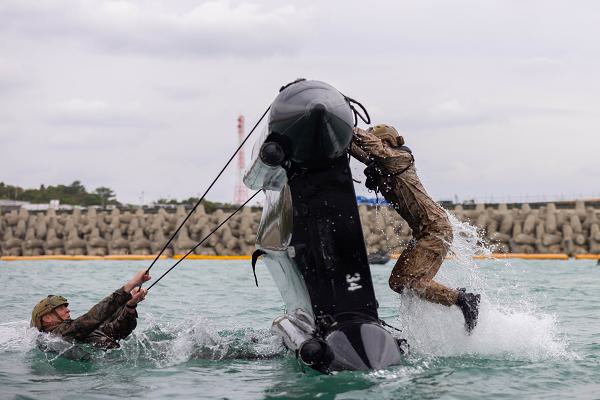- Details
- Hits: 4239

Atlantic Ocean. (February 6, 2025): Ancient mariners were both terrified and reassured by this strange light that seemed to envelope their ships during lightning storms. In this photo by Staff Sergeant Jackson Manske, Captain Russell Ellis flies a routine tanker mission as St. Elmo's Fire, a weather phenomenon, flashes across the window.
St. Elmo's Fire, also called witch’s fire, occurs when a strong electrical field builds up in the atmosphere, usually during a thunderstorm, causing plasma discharges that produce a bluish or violet glow. These lights appear when electrical fields encounter a rod-like object such as a ship’s mast, a chimney, or in this instance the leading edges of an aircraft. The intensity of the lights are determined by the nitrogen and oxygen levels in the Earth's atmosphere and the effect is often accompanied by a hissing or buzzing sound proportional to the strength of the electric field.
- Details
- Hits: 3207

Okinawa. Japan. (February 4, 2025): For military recruits, it is hard to tell if an exercise is meant for pure torture or the best workout routine on the planet. In this photo by Lance Corporal Sav Ford, Marines assigned to Air Support Squadron 2 flip tires during a field meet to commemorate the squadron's 82nd anniversary. While it may seem pointless, tire flipping has some serious science behind it.
First of all, it is a full body exercise that few can match. Flipping tires trains so much muscle while it burns a lot of calories. The routine engages multiple muscle groups simultaneously through one compound movement targeting the back muscles, forearms, biceps, and triceps. Meanwhile, the cardiovascular component makes tire flipping and outstanding choice for improving endurance and overall physical performance. Doing just twenty minutes a day can burn at least four hundred calories.
- Details
- Hits: 3286

Okinawa, Japan. (January 23, 2025): If you have ever fallen out of a canoe, you can identify with these Marines as they practice flipping a raiding craft during small boat training (photo credit by Corporal Noah Masog). When it happens to civilians, it can be embarrassing. For Marines conducting a raid, getting a raft flipped back over quickly could mean the difference between life or death.
Officially called a “Combat Rubber Reconnaissance Craft” (CRRCs), the Marines refer to them as Zodiacs after their manufacturer. It is used to insert lightly armed raiding parties or reconnaissance teams onto beaches undetected. CRRCs are light weight, easily stowed, and can be inflated in minutes by foot pump. Their buoyancy allows up to ten troops to negotiate rough seas as they approach the beach. This is also when Marines find themselves flipped over into the surf struggling to right their vessel. Believe it or not, there is a whole lot of physics involved in flipping a raft.
Read more: DON’T FLIP OUT… MARINES PRACTICE RECOVERING ZODIACS
- Details
- Hits: 3179

Port Hueneme, California. (January 31, 2025): What sets Navy divers apart is that they are continuously surrounded by that which can kill them. Unlike surface warriors, Navy divers can die if they make even one mistake deep beneath the waves. In this photo by Lisa Ferdinando, Navy Lieutenant Commander Igor Vladimirov and Petty Officer 2nd Class Cody Kramer receive emergency scuba training at the Naval Facilities Engineering and Expeditionary Warfare Center here. The Center trains divers how to respond to underwater emergencies including rescuing lost, trapped, or unconscious divers and how to treat a variety of dive-related illnesses.
During the arduous training, divers are confronted with real-world scenarios and evaluated on their ability to respond appropriately. Students are challenged to locate lost or trapped divers and how to safely rescue someone who is unconscious. Students learn how to use emergency oxygen to treat scuba diving injuries, assess neurological damage, and the proper first aid to apply.
- Details
- Hits: 3313

McMurdo Sound, Antarctica. (February 1, 2025): It may not be everyone’s idea of a day at the beach, but these Coast Guard members eagerly soak up the Antarctic sun. In this photo by Petty Officer 2nd Class Jeremy Burgess, the crew of the Coast Guard Cutter Polar Star enjoys ice liberty during Operation Deep Freeze. The operation is an annual mission on behalf of the U.S. Antarctic Program to resupply outposts in the Antarctic. The Polar Star and crew operate America’s only heavy ice breaker, making them essential to U.S. research efforts at the bottom of the world.
In 1959, the U.S. and eleven other countries signed the Antarctic Treaty ensuring that the region is dedicated “solely to peaceful purposes and free from international conflict”. The United States has established three bases, McMurdo, Amundsen-Scott, and Palmer as year round research facilities.
- Details
- Hits: 3157

Camp Lejeune, North Carolina. (January 23, 2025): In 256 BC during the siege of the Persian city Dura Europos (modern Syria), Sasanian forces used a mixture of tar and sulfur to gas the enemy. Later, the Athenians resorted to poisoning water supplies with deadly herbs while the Mongols catapulted diseased corpses over the walls of a besieged city. It appears chemical and biological warfare has been a part of combat since ancient times. In this photo by Sergeant Jacquilyn Davis, Marines with II MEF Information Group walk through CS gas during a battalion field exercise. Like their warrior predecessors, the Marines must be ready to confront a wide variety of deadly Chemical, Biological, Radiological, and Nuclear (CBRN) materials.
The first category of CBRN threats involve man-made chemical agents designed to attack the central nervous or respiratory systems. The most common “nerve agent” is Sarin, an odorless gas that causes seizures, paralysis, difficulty breathing, and death. Another category is “blister agents” including Sulfur Mustard Phosgene (Mustard Gas) that causes blindless, lung damage, and death by asphyxiation. Finally, there are “blood agents,” like Cyanide, which deprive the body of oxygen and cause death.


